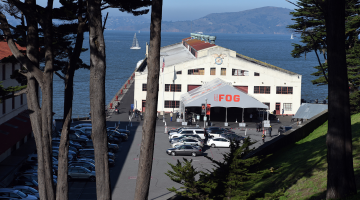The studio portraits in Ryan McGinley’s solo exhibition “Yearbook” at Ratio 3 Gallery are irreverent and sexy. They build on the artist’s decade-long tradition of photographing the tattooed and always naked on cross-country road trips and, in recent years, in the studio. Like his 2012 show “Animals” at Team Gallery, New York, “Yearbook” depicts young, hip things in full color, minus the close encounters with boa constrictors, lemurs and ibex.
The element of risk that marks much of his preceding work is likewise absent, distilling the photographs papered on the walls into a three-pronged interaction between McGinley, models and camera. Minus the threat of arrest for public nudity or of bodily harm from a marmoset wrapped around one’s member, his work still shines with intimacy. McGinley’s models are by turns alluring, awkward and unsure and their portraits reflect in a kaleidoscope of color and affect. Printed on normal paper and presented unframed, the works turn your head in every direction.
But I wonder what the point is, or where this is all heading. McGinley was rewarded with skyrocketing success early on. He became one of the youngest artists to have a solo show at the Whitney Museum in 2003 at the age of 25. Just as Nan Goldin’s work is bound up with the free, troubled and artistic spirits with whom she spent her time, McGinley’s earliest work features the skateboarders and graffiti artists who remain his close friends. His images of people running naked through sunlit fields and stepping off of tree branches as they would an escalator call to our inner wild child and celebrate life lived in the moment. Before the explosion of photographic content online, his stood out and for good reason.
Like Goldin, McGinley has photographed black eyes and scratched skin, but his marks signify differently. Goldin’s powerful self-portrait a month after being abused rings true because the violence happened. It was not staged. McGinley’s models take risks for the sake of a good shot and his choice to portray bruised bodies might ring a little false. In a 2012 interview with Bill Powers, McGinley says, “It’s not about me. What I’m doing isn’t real, you know, it doesn’t relate to the real world. It’s a fantasy world that I’m creating.” It’s clear that the artist isn’t aiming for authenticity or self-reflection – his photographs are carefully orchestrated and never feature himself. While he concedes, “every picture has my handwriting,” he rejects the notion that every work of art is some sort of self-portrait. I admit it might be comparing apples and oranges to bring up Goldin or Larry Clark, since McGinley is aiming for something so different.
He does have a good thing going, but I wonder what he will be doing in ten years and if he will still be photographing young beautiful people. Will another phase of life capture his attention? “The most beautiful sensation is closing your eyes and dancing,” he says. “That’s what I want my photos to feel like.” Live music plays a big part in his life and he has expressed interest in making an independent film. Movement and motion are central in his photography, and it would be interesting to see him set the lyricality of the human body against music and the moving image.
The exhibition runs through October 19. For more information visit here.
-Contributed by Ariel Rosen





